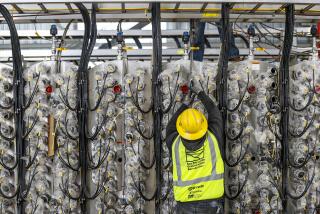Problems at Plant Raise Questions on Use of Water : Tillman: An inspection finds high levels of bacteria and malfunctioning pumps. But officials defend the facility and a plan for recycling its discharge.
Operating problems at the Tillman sewage treatment plant in the Sepulveda Basin have raised questions about the proposed use of reclaimed water from the plant to stretch city drinking water supplies.
A January inspection of Tillman by the State Water Resources Control Board found several maintenance and performance problems, including malfunctioning of certain measuring instruments and pumps, and occasional excessive levels of coliform bacteria in the plant discharge, according to a Feb. 19 letter from the state to the city Department of Public Works.
The Los Angeles Department of Water and Power has proposed an ambitious recycling project that would use up to 50 million gallons per day of reclaimed water from Tillman. The treated water would be used for irrigation and industrial cooling, and to replenish ground-water supplies that are tapped by city wells.
The water would be piped northeast to water spreading grounds in Sunland and Pacoima--porous sand and gravel basins through which water percolates into the ground. The water would mix with ground water and, after a few years, seep south to wells in North Hollywood that provide part of Los Angeles’ drinking water supply.
The proposal, called the East Valley Water Reclamation Project, will be the subject of a public meeting at 7 tonight at Francis Polytechnic High School, 12431 Roscoe Blvd., Sun Valley.
The state’s January inspection related to the city’s performance under grants awarded for construction of Tillman. It was not directly connected with the reclamation project.
But some residents said the findings validate their concern about using the Tillman discharge to boost ground-water supplies.
Officials with the Department of Public Works--which runs Tillman--and with the DWP--proponent of the reclamation project--defended the performance of the plant and the reclamation plan.
“This plant is a great performer,” said Bradley Smith, division engineer with the Department of Public Works.
If plant effluent failed to meet state standards, diversion of the water to the spreading grounds would cease, said Walter Hoye, director of water engineering for the DWP.
“That’s exactly what I would expect they would say because they’re under pressure to recycle water,” said Gerald A. Silver, president of Homeowners of Encino. “If one wants to say, ‘Fine, just trust them’ . . . and allow them to be the judge and jury on this, I don’t think that’s responsible.”
Tillman is a tertiary treatment plant, meaning that it is designed to provide sophisticated treatment. Its treatment capacity is being doubled from 40 million gallons of waste water per day to 80 million gallons. Presently, its discharge flows into the Los Angeles River and out to sea.
Winnie Jesena, a senior engineer with the State Water Quality Control Board for the Los Angeles region, said the elevated coliform levels were detected during two weeks last spring, when dirt from construction work may have spilled into a water tank.
“They are in compliance except for a blip here and a blip there, and you cannot have a 100% sure shot,” Jesena said.
Coliform is an indicator of fecal pollution. The bacteria are filtered by soil and cannot survive for long periods outside the bodies of warm-blooded animals. But coliform counts are a concern because they may indicate the presence of viruses.
Bart Christensen, the state associate water resources control engineer who signed the inspection letter, said the coliform levels were “not extremely high and I think the problem is correctable.”
Since the 1960s, the Los Angeles County Sanitation Districts have been spreading treated effluent from sewage treatment plants to replenish aquifers from which numerous cities and water districts in southern Los Angeles County draw part of their water. In Orange County, treated waste water is drawn out of the Santa Ana River channel and used for ground-water recharge.
More to Read
Sign up for Essential California
The most important California stories and recommendations in your inbox every morning.
You may occasionally receive promotional content from the Los Angeles Times.










